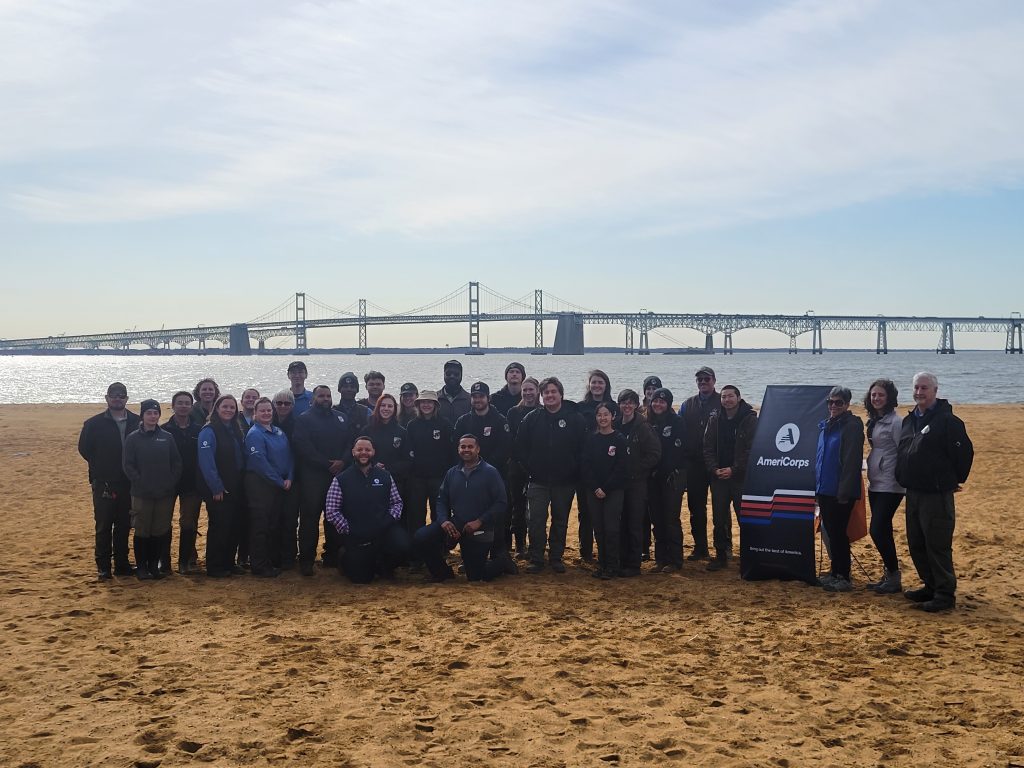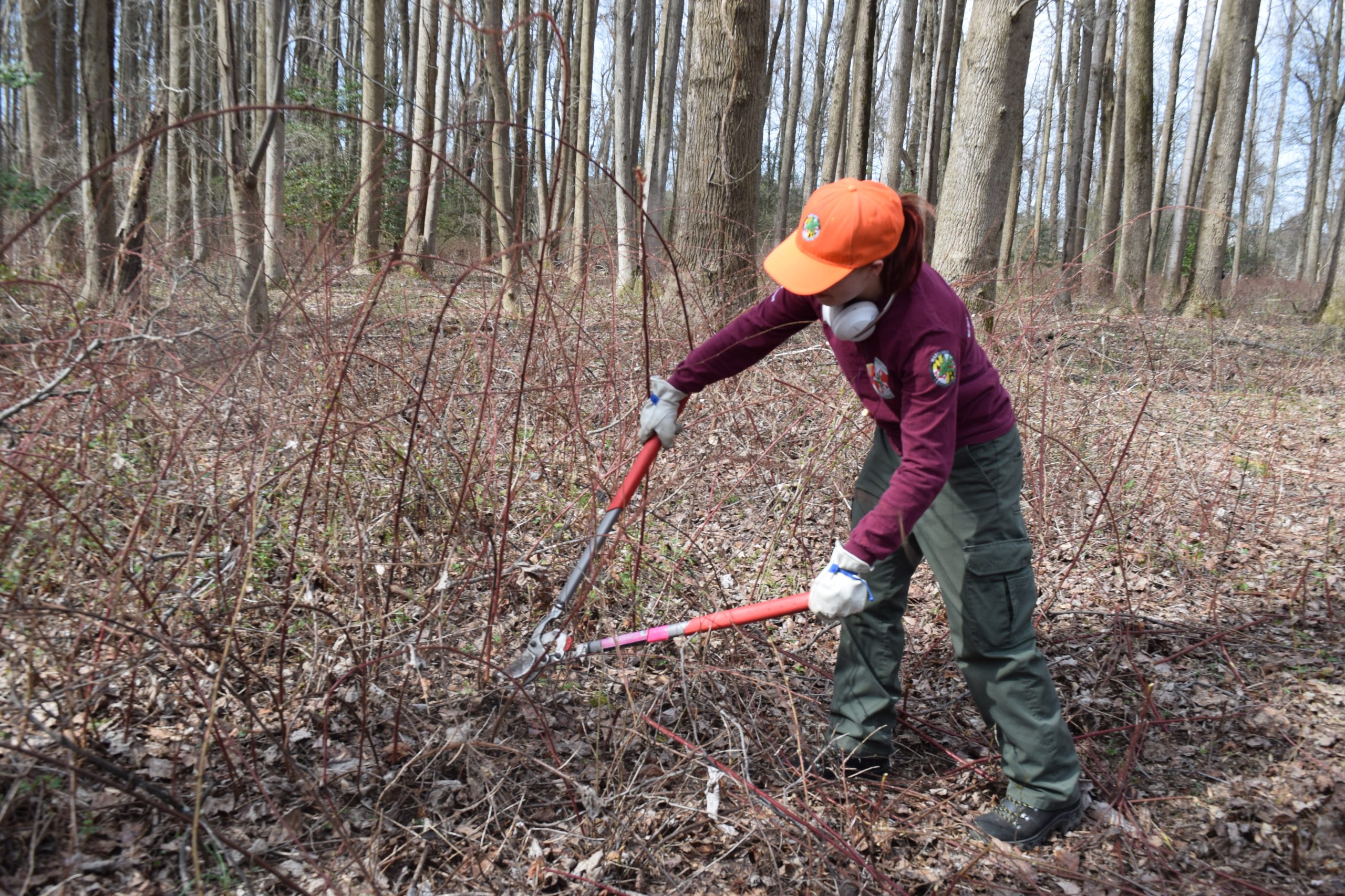Maryland Conservation Corps Members Kick off AmeriCorps Week With Invasive Plant Removal Project
The Conservation Corps is a partnership between the Department of Natural Resources and AmeriCorps

Maryland Conservation Corps members pose with state and AmeriCorps officials in front of the Chesapeake Bay Bridge at Sandy Point State Park. Photo by Joe Zimmermann/Maryland DNR
Maryland Conservation Corps members gathered at Sandy Point State Park on Tuesday to share stories about why they felt called to serve and what they’ve learned from their work, before setting out for a day of cutting back invasive plants.
As part of AmeriCorps Week, the event brought representatives from AmeriCorps and Maryland state agencies to the Chesapeake Bay-front park in Annapolis to celebrate the ongoing achievements of the Maryland Conservation Corps. A partnership between AmeriCorps and the Maryland Department of Natural Resources, the Conservation Corps places about 40 members across eight state parks every year.
At the event, the Maryland Department of Service and Civic Innovation presented AmeriCorps CEO Michael Smith with a proclamation from Gov. Wes Moore declaring this week as AmeriCorps Week in Maryland, noting how the service work through the program strengthens members, communities, and the state as a whole.
In view of the Bay, Conservation Corps members spoke about what they’ve gained from the program, from learning teaching skills and environmental education to working a chainsaw and getting out of their comfort zone.
Elizabeth Butz, a Conservation Corps and AmeriCorps member at Susquehanna State Park, said she joined because she had a passion for the environment and thought it was a good opportunity to learn job skills.
“It’s been a really great way to give back to those parks that I grew up going to,” she said. “And then I’ve learned a lot about being able to do environmental education especially, so it lets me turn my passions into a way to educate others.”
Rory Fisher, who was a Conservation Corps and AmeriCorps member at Gunpowder Falls State Park last year and is now a Conservation Corps crew lead at Merkle Wildlife Sanctuary, said service work has been meaningful to him and he hopes to help make parks more welcoming to the Black community and other minority groups.
“What I’ve learned throughout my time at Conservation Corps is that I really enjoy serving, and I think I want to just take that with me for the rest of my life,” he said. “One of my big goals is to definitely just to get more people that look like myself out in the parks and outside, so I just try to be an influence on more people.”
Smith, the AmeriCorps CEO, said the members’ stories were testimonies to the “transformative power of service” and thanked the members for their hard work and sacrifices. He noted that this is a time when many young people are experiencing climate anxiety, and programs like Conservation Corps and the new American Climate Corps offer a path for constructive action to protect the planet and local communities.
“I think what you demonstrate and you show is we can move from anxiety to action,” Smith said. “We can dig in and we can make a difference. So thank you for making that difference and getting things done, and for giving me a great way to kick off AmeriCorps week. I’m excited to serve alongside you.”
After the gathering at the Nature Center at Sandy Point, the Conservation Corps teams headed a few minutes down the road to the Corcoran Environmental Study Area, where DNR’s Chesapeake and Coastal Service has been conducting extensive efforts to tackle the forest’s proliferation of invasive plants.
Invasive vines there have been enough to fell record-size trees, and each tree that falls opens up more areas to invasive species, said Sarah Hilderbrand, a senior restoration specialist for the Department of Natural Resources. It’s intensive work—where every time one plant gets under control, another pops up—which is why it’s helpful to bring big teams out to work together.

Azalin Rothwell, a Conservation Corps member at Merkle Wildlife Sanctuary, cuts a wineberry shrub. Wineberries have red stems covered by dense, often soft thorns. Cutting them near the base helps slow further growth. Photo by Joe Zimmermann/DNR
The Corcoran effort is what Conservation Corps calls a “surge project,” where several crews come to one park to work together on bigger initiatives, said Ranger Sara Marcinak, the Conservation Corps director. Often, she said, park staff are surprised by how fast and efficiently the crews can finish big projects.
Conservation Corps members took up shears and cutters and put on work gloves and ear protection and set off into the Corcoran woods. Spreading out into three teams, they went after wineberry, bamboo, Japanese honeysuckle, Oriental bittersweet and other plants, slicing them off at the stem to slow further growth.
“It’s been a really great partnership with the Maryland Conservation Corps, and we’ve really started trying to reverse the degradation and work towards forest health in Corcoran,” Hilderbrand said. “We’re trying to reclaim those areas, and we’ve used teams like yours to get the forest health up.”
The Maryland Conservation Corps started in 1984 and became an AmeriCorps program in 1994. It receives funding from the Department of Natural Resources and AmeriCorps. The program is open to young adults aged 17 to 25, who will serve 10 and a half months. Each member primarily serves in one state park, though they also participate in projects across the state. Applications are open and are reviewed from February to September. Last year, the Maryland Conservation Corps graduated 35 members who completed at least 1,700 hours of community service.

 1-888-373-7888
1-888-373-7888 233733
233733